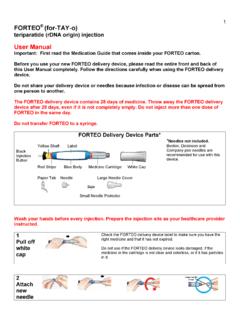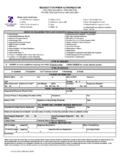Transcription of Data Sheet FORTEO - Medsafe
1 FORTEO -ds-v 7. 0-28feb14 Page 1 of 13 data Sheet FORTEO teriparatide 250 microgram/mL, solution for injection Presentation Teriparatide (rhPTH(1-34)) is identical to the 34 N-terminal amino acid sequence of endogenous human parathyroid hormone, and is manufactured using recombinant DNA technology. FORTEO 250 microgram/mL solution for injection is supplied as a mL cartridge contained in a prefilled disposable delivery device (pen). FORTEO 250 microgram/mL solution is a sterile, colourless, clear, isotonic solution intended for subcutaneous injection. The pen delivers 20 microgram per dose and contains dosing for 28 treatment days. Uses Actions Endogenous 84-amino-acid parathyroid hormone (PTH) is the primary regulator of calcium and phosphate metabolism in bone and kidney. Physiological actions of PTH include stimulation of bone formation by direct effects on bone forming cells (osteoblasts), indirectly increasing the intestinal absorption of calcium and increasing the tubular re-absorption of calcium and excretion of phosphate by the kidney.
2 The biological actions of PTH are mediated through binding to PTH-specific cell-surface receptors. Teriparatide (rhPTH(1-34)) is the active fragment (1-34) of endogenous human parathyroid hormone, manufactured using recombinant DNA technology. Teriparatide binds to these receptors with the same affinity as PTH, and has the same actions in bone and kidney as PTH. Like endogenous PTH, teriparatide is not expected to accumulate in bone or other tissues. Pharmacodynamics Teriparatide is a bone formation agent to treat osteoporosis. The skeletal effects of teriparatide depend upon the pattern of systemic exposure. Once-daily administration of teriparatide increases apposition of new bone on trabecular and cortical (endosteal and periosteal) bone surfaces by preferential stimulation of osteoblastic activity over osteoclastic activity. In contrast, continuous excess of endogenous PTH, may be detrimental to the skeleton because bone resorption may be stimulated more than bone formation.
3 Pharmacokinetics After subcutaneous injection, teriparatide has an absolute bioavailability of 95%. Absorption and elimination are rapid. Following a subcutaneous injection of a 20-microgram dose, peak molar concentrations of teriparatide briefly exceed the upper limit of normal for endogenous PTH (65 picogram/mL [ picomolar]) by 4- to 5 fold for about 30 minutes and decline to non-quantifiable concentrations within 3 hours. The mean systemic exposure (endogenous PTH and teriparatide) over 24 hours does not exceed the upper limit of normal and is below the levels found in patients with mild hyperparathyroidism. Teriparatide is eliminated through hepatic and extra-hepatic clearance (approximately 62 L/hr in women and 94 L/hr in men). The volume of distribution is approximately L/kg. Between-subject variability in systemic clearance and volume of distribution is 25% to 50%. The half-life of teriparatide is approximately 1 hour when administered subcutaneously.
4 No metabolism or excretion studies have been performed with teriparatide. However, the mechanisms of metabolism and elimination of PTH(1-34) and intact PTH have been FORTEO -ds-v 7. 0-28feb14 Page 2 of 13 extensively described. Peripheral metabolism of parathyroid hormone is believed to occur predominantly in liver and kidney. Age No differences in teriparatide pharmacokinetics were detected with regard to age (range 31 to 85 years). Dosage adjustment based on age is not required. Gender Systemic exposure to teriparatide is approximately 20% to 30% lower in men than in women. There were, however, no gender differences with respect to safety, tolerability, or pharmacodynamic responses. Dosage adjustment based upon gender is not required. Renal Impairment No clinically relevant pharmacokinetic or safety differences were identified in patients with mild, moderate, or severe chronic renal impairment administered a single dose of teriparatide, therefore dosage adjustment based on mild to moderate renal impairment is not required.
5 However, patients with renal impairment had reduced calcaemic and calciuric responses to teriparatide. Long-term safety and efficacy have not been evaluated in patients with creatinine clearance <30 mL/min and thus teriparatide should not be administered to patients with severe renal impairment (see Contraindications). Heart Failure No clinically relevant pharmacokinetic, blood pressure, pulse rate or other safety differences were identified in patients with stable heart failure (New York Heart Association Class I to III and additional evidence of cardiac dysfunction) administered two 20-microgram doses of teriparatide. Dosage adjustment based on the presence of mild or moderate heart failure is not required. There is no data from patients with severe heart failure. Hepatic Impairment Safety and efficacy have not been evaluated in patients with hepatic impairment. Animal studies have shown that severely reduced hepatic blood flow decreases exposure of PTH to the principal cleavage system and consequently clearance of PTH(1-84).
6 In vitro studies have demonstrated that high capacity liver-specific phagocytic cells in the hepatic sinusoidal capillaries, the hepatic Kupffer cells, rather than hepatocytes, are the principal site for the cleavage of PTH(1-34) and PTH(1-84) into fragments that are consequently cleared from the circulation by the kidney. Thus, it is unlikely that hepatic impairment will have a clinically significant effect on systemic exposure to teriparatide. Clinical Efficacy Risk Factors Independent risk factors, for example, low BMD, age, the existence of previous fracture, family history of hip fractures, high bone turnover and low body mass index should be considered in order to identify women and men at increased risk of osteoporotic fractures who could benefit from treatment. Premenopausal women with glucocorticoid-induced osteoporosis should be considered at high risk for fracture if they have a prevalent fracture or a combination of risk factors that place them at high risk for fracture ( , low bone density [ , T score 2], sustained high dose glucocorticoid therapy [ , mg/day for at least 6 months], high underlying disease activity, low sex steroid levels).
7 FORTEO -ds-v 7. 0-28feb14 Page 3 of 13 Postmenopausal Osteoporosis The pivotal study included 1637 postmenopausal women (mean age years), 1326 of whom had baseline and postbaseline follow-up vertebral x-rays. At baseline ninety percent of the patients had one or more vertebral fractures and on average, vertebral BMD was g/cm2 (equivalent to a T-score = - ).. Patients with metabolic bone disorders other than osteoporosis were excluded from the study. All patients received 1000 milligrams of calcium per day and at least 400 IU of vitamin D per day. Results from a treatment period of up to 24 months (median 19 months) with teriparatide, demonstrate significant anti fracture efficacy. Effect on Vertebral Fractures Teriparatide given for a median of 19 months significantly reduced the risk and severity of new vertebral fractures in postmenopausal women with osteoporosis, relative to placebo.
8 Teriparatide reduced the incidence of one or more new vertebral fractures by 65% and multiple fractures by 77% (Table 1). Eleven women would need to be treated with teriparatide for a median of 19 months to prevent one or more new vertebral fractures. Effect on Non-vertebral Fractures Teriparatide significantly reduced the overall incidence of fragility non-vertebral fractures including wrist, ribs, ankle, humerus, hip, foot, pelvis and others, by 53%. Effect on BMD Teriparatide rapidly increased lumbar spine BMD. Significant increases were seen as early as 3 months and continued throughout the treatment period. After a median treatment period of 19 months, BMD had increased 9% and 4% in the lumbar spine and total hip, respectively, compared with placebo (p< ). Teriparatide was effective regardless of age, baseline rate of bone turnover, and baseline BMD. In an open-label study, 503 postmenopausal women with severe osteoporosis and a fragility fracture within the previous 3 years (83% had received previous osteoporosis therapy) were treated with FORTEO for up to 24 months.
9 At 24 months, the mean increase from baseline in lumbar spine, total hip and femoral neck BMD was , and respectively. The mean increase in BMD from 18 to 24 months was , , and at the lumbar spine, total hip and femoral neck, respectively. Effect on Back Pain Teriparatide significantly reduced the incidence and severity of back pain. In women with postmenopausal osteoporosis, there was a significant (p = ) 26% reduction in the spontaneous reports of new or worsened back pain compared to placebo. Effect on Height Loss For the 86 postmenopausal women who experienced vertebral fractures, those treated with teriparatide had significantly less height loss when compared to placebo (p = ). Bone Histology The effects of teriparatide on bone histology were evaluated in iliac crest biopsies of 61 postmenopausal women treated for up to 24 months with placebo or teriparatide 20 microgram or 40 microgram per day.
10 The increases in BMD and resistance to fracture achieved with teriparatide occurred without evidence of cellular toxicity or adverse effects on bone architecture or mineralisation. The findings in human bone samples paralleled those seen in preclinical primate studies. FORTEO -ds-v 7. 0-28feb14 Page 4 of 13 Table 1 Fracture Incidence in Postmenopausal Women Placebo (N=544) (%) Teriparatide (N=541) (%) Relative risk (95% CI) vs. placebo New vertebral fracture ( 1)a b ( , ) Multiple vertebral fractures ( 2)a b ( , ) Moderate or severe vertebral fracture ( 1) a ( , ) Non-vertebral fragility fractures c c ( , ) Major non-vertebral fragility fracturesc (hip, radius, humerus, ribs and pelvis) c ( , ) Abbreviations: N = number of patients randomly assigned to each treatment group; CI = Confidence Interval.














